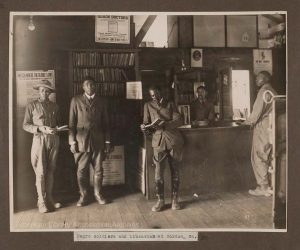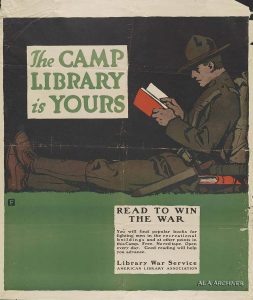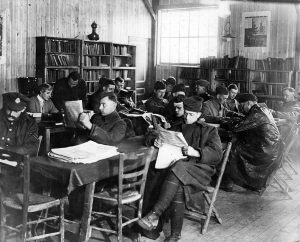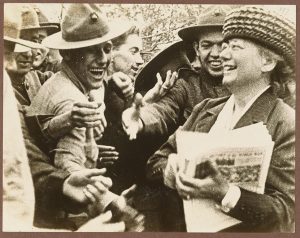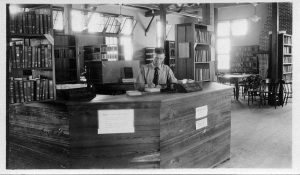THE CAMP LIBRARY IS YOURS
The camp library served as a place of recreation and education for soldiers both in the United States and abroad. While the American Library Association would raise funds with the help of the Carnegie Corporation to build thirty-six library buildings, most of the libraries were housed in YMCA and Knights of Columbus recreation buildings or YWCA hostess houses. The libraries were filled with books, periodicals, and even games for the soldiers to play. For servicemen who were stationed on naval ships, the Association sent reading materials to ships and naval stations.
The library was a popular and important place for many soldiers. A letter by serviceman to his father was published in the War Library Bulletin, where he wrote about the camp library and his taste in literature, saying, “We read, of course. But there never could be a library here big enough to keep us going. We can do with all sorts of books, but I don’t think the ordinary sensational novel is quite the catch it was for a lot them in peace times … I used to imagine reading was meant to be a stimulant, but here it has be an anodyne.”
For many soldiers waiting to be deployed or already overseas, books became a source of entertainment and solace to fill idle hours in the camps and the trenches. For other soldiers, the camp library and books provided by the Library War Service were chance for them to learn to read. A 1918 issue of War Libraries draws attention to the fact that 12,000 “stevedores” (dockworkers) near the ports where U.S. transport ships and supplies landed in France had their first chance to learn to read through the efforts of the Library War Service and others:
… the first chance they ever had to learn to read and write came to them in their barracks on foreign soil … They crave books of all kinds, books to advance them in their work after the war, books to make them forget the hard labor which is their contribution to the war for liberation. Small wonder that the first consignment of books sent over was placed at the disposal of these men.
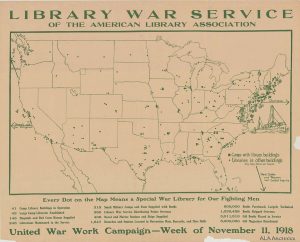
THE READING MATERIAL
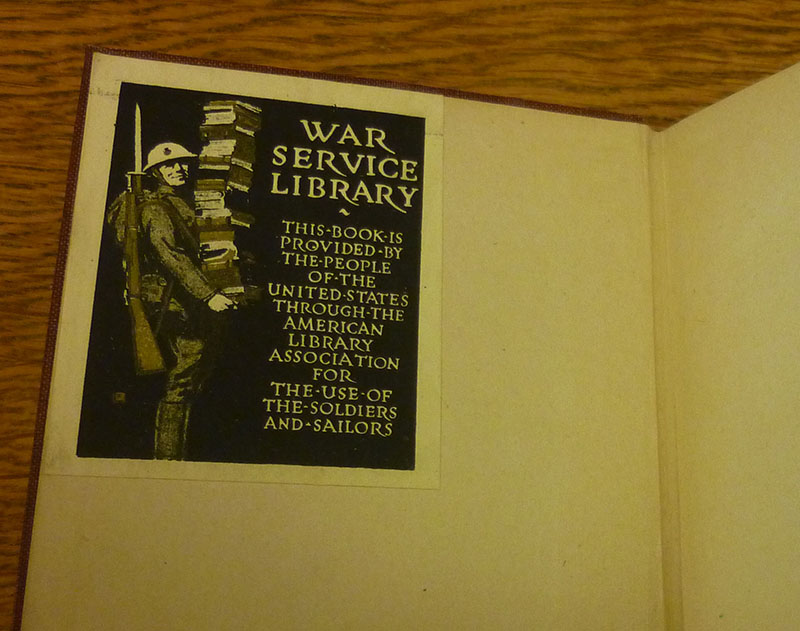
The American Library Association sought out a variety of books and reading materials for the servicemen. This included novels, poetry, non-fiction books, training manuals, and magazines. The largest demand was for non-fiction materials that helped servicemen perform their duties and to prepare them for obtaining a job back home.
L.W. Josselyn, the librarian at Camp Johnston in Florida, made every technical and military science book in the library a reference book, which could not circulate due to the high demand for them. In the War Library Bulletin, Josselyn was quoted, “It’s amusing to see men lined up to get Carter’s ‘Horses, Saddles and Bridles’ or Captain Hayes’ ‘Veterinary Notes.’ If I circulated the ‘Quartermaster’s Manual,’ I would need a thousand copies.”
Burton Stevenson observed that the demand for technical books could be due to the fact that, “War has become very largely a matter of machines, and expert knowledge of these machines is the first essential to efficiency.” Stevenson noted that soldiers were interested in books on signaling and drilling, aviation, gas engines, hydraulics, and electrical work, and that the books needed to be up to date and covering advance studies on the topics. All were topics and knowledge that could help a soldier better perform his duties. There was also a demand for books on French customs, demonstrating efforts by soldiers to try to understand the country they were being shipped to.
BANNED BOOKS
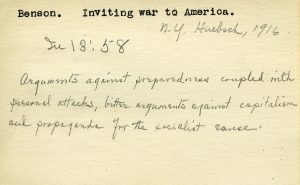
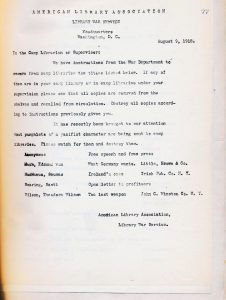
Not every book was deemed suitable for the camp library. A listing of banned books circulated through the Library War Service, often at the discretion of the War Department. These books were often considered pacifist, pro-German, anti-capitalist, and pro-socialist, and were thought to be inappropriate for American and allied soldiers. Librarians sometimes received orders to remove such books from circulation and to destroy them.
One distributed letter from the Library War Service headquarters in Washington noted that pamphlets of a pacifist nature were being circulated around camps and librarians received instructions that, “If any of them are in your camp library or in camp libraries under your supervision please see that all copies are removed from the shelves and recalled from circulation. Destroy all copies according to instructions previously given to you.”
The act of banning books did not go unnoticed. Newspapers and magazines made note of and listed books that were banned in camp libraries. It wasn’t until December 1918, after the war, when banning certain books in camp libraries came to an end.
